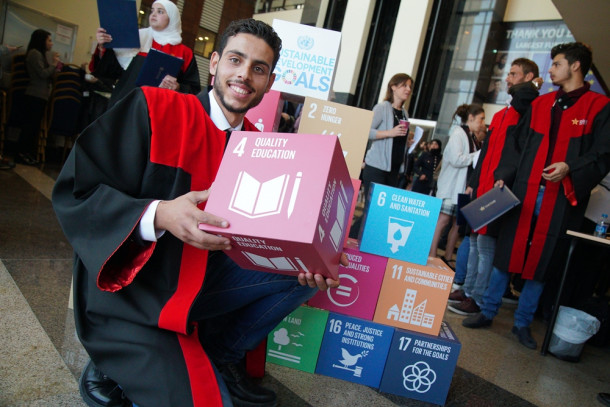Article
How fast are countries transforming their education? What you need to know about the new 2023 SDG 4 Scorecard

The 2023 SDG4 Scorecard shows how fast countries are progressing towards their national benchmarks. It is the start of a new annual series of reports that will be published on the International Day of Education (24 January) each year.
What are national SDG 4 benchmarks?
As this blog explains in more detail, national SDG 4 benchmarks are national targets that countries have set themselves to be achieved by 2025 and 2030 on seven key education indicators: Early childhood education attendance; out-of-school rates; completion rates; gender gaps in completion rates; minimum proficiency rates in reading and mathematics; trained teachers; and public education expenditure.
A key outcome from the Transforming Education Summit was to add three more indicators to the SDG 4 monitoring framework with associated national benchmarks on greening education, digital transformation and youth and student engagement in policy making. Work defining these indicators is ongoing.
Why are countries setting benchmarks?
National SDG 4 benchmarks serve multiple objectives. Most importantly, they help contextualize the monitoring of progress towards our education targets. Benchmarks recognize that each country has a different starting point but also that all countries together have been observed historically to progress at a certain pace. The benchmarking process challenges countries to commit to progress faster than if they followed these past trends.
What do countries’ benchmarks show?
So far three in four countries have submitted benchmarks, or national targets, to be achieved by 2030.
Some countries’ benchmarks demonstrate very high ambition, committing to improve faster than the historic rate of the top 25% of countries. Ambitions are particularly high for improving learning outcomes in primary level among poorer countries with low starting values, which may be because these countries lack data and are less familiar with its progress.
The work on benchmarks has shown an acute lack of data on our education targets. Half of countries have no data on learning levels or the percentage of trained teachers in primary schools; a third have no data on completion or out-of-school rates.
What does the SDG 4 Scorecard show?
The SDG 4 Scorecard highlights how countries are progressing towards their SDG 4 benchmarks.
Among countries with benchmarks, most are progressing well on primary completion rates, but out-of-school rates regressed in 1 in 10 countries between 2015 and 2020. At least one in three countries regressed in learning proficiency and in trained teachers at the pre-primary and primary level.
This first ever progress report looks in depth at two indicators – upper secondary completion and early childhood education participation – for both, barely one in three countries are well placed to achieve their national benchmark for 2025 with high probability; these were mostly richer countries.
In the case of the upper secondary completion rate, most countries have made slow rather than fast progress. Rwanda is the only low-income country to have achieved fast progress; most other low-income countries either have insufficient data or no national target. Most lower-middle-income countries are managing only slow change, although seven countries stand out for their fast progress: Bangladesh, Bolivia, Egypt, El Salvador, Ghana, Kyrgyzstan and Nepal.
In the case of the pre-primary education participation rate, high-income countries are more likely to have achieved fast progress. By contrast, lower-middle income countries have achieved slower progress and are less likely to achieve their national target by 2025. Nevertheless, there are 14 low- and lower-middle-income countries that are on track to achieve their benchmarks: Burkina Faso; Burundi; Bhutan; Cambodia; Côte d'Ivoire; Ghana; Guinea; India; Kyrgyzstan; Republic of Moldova; Rwanda; Sierra Leone; Vanuatu; and Viet Nam.
One in three countries – and two in three low-income countries – do not meet either of the two minimum benchmarks on education finance. Among countries with data, 64% of low-income countries relative to 29% of middle- and high-income countries fell below both benchmarks. Data availability is a more important issue in poorer countries: 24% of low-income countries, 15% of middle-income and 6% of high-income countries report no data on public expenditure.
What can help countries reach their benchmarks on early childhood education?
The purpose of the benchmarking exercise is not only to show progress but help countries see the links of progress with specific policies. Three policies are shown to be important for the pre-primary education participation rate:
Legislate: Offer free and compulsory pre-primary education: In 2020, 91 out of 188 countries guaranteed zero years of free and compulsory pre-primary education in their legislation. Yet countries which guarantee at least one year of free education, have higher participation rates and higher benchmark values.
Regulate: Given the large share of private providers in pre-primary education, governments must regulate them to ensure quality and equity. While 97% of countries regulate approval, licensing and establishment of private pre-primary education providers, only 26% of countries support specific vulnerable populations’ tuition fee payments and just 15% prohibit non-state providers from operating for profit. In countries where tuition fees for specific population groups are subsidized, the percentage of children who participate in organized learning one year before entry to primary school is higher by 13 percentage points, whereas countries with fee-setting regulations have a 7 percentage-point higher participation.
Finance: Spending on publicly provided pre-primary education increases enrollment. Among the 80 countries with data in 2018–20, 0.43% of GDP was spent on pre-primary education. Four countries spent above 1% of GDP: Belarus, Ecuador, the Republic of Moldova and Sweden. Doubling spending from 0.25 to 0.50 of GDP, triples participation rates from 20% to 60% on average.





